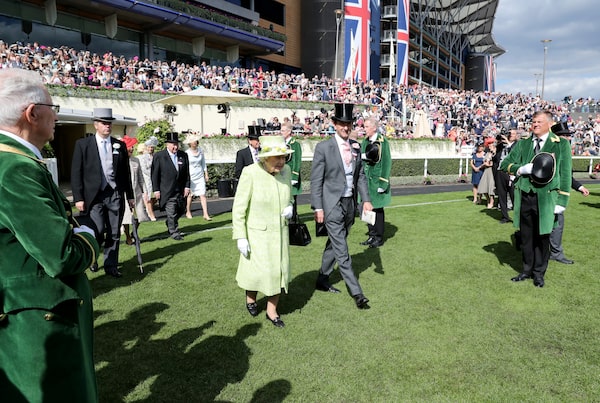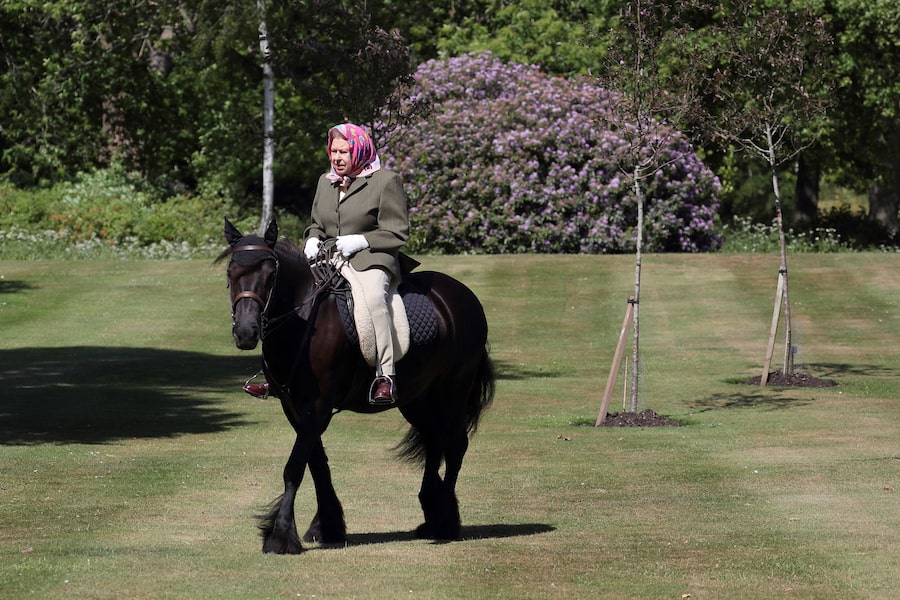
Queen Elizabeth meets Harlequin, a horse she gave to the Kings Troop as she visits the King's Troop Royal Horse Artillery at Woolwich Barracks in south east London, on May 31, 2013.PAUL GROVER/AFP/Getty Images
To understand just how much the Queen loved horse racing, look no further than her eldest son’s second wedding.
A rocky path had already preceded Prince Charles’s marriage to Camilla Parker Bowles on April 9, 2005, because the bride and groom were both divorced. Then the death of Pope John Paul II delayed the wedding for a day.
Finally – and most crucially for the Queen – the new wedding date clashed with the country’s most famous steeplechase, the Grand National. The starting time for the race was delayed by half an hour so that television viewers could see both the royal nuptials in Windsor and the race.
Just as Prince Charles and his new bride emerged from St. George’s chapel, the Queen and a few other sports fans hurried into a room with a television so they could watch the race. Later that night, as she gave a toast to the couple at their reception, guests might have wondered which of the day’s events the Queen was more excited about.
“I have two important announcements to make. I know you will want to know who was the winner of the Grand National. It was Hedgehunter,” she said. “Secondly, having cleared Becher’s Brook and The Chair and all kinds of other terrible obstacles, they have come through and I’m very proud and wish them well. My son is home and dry with the woman he loves. They are now on the home straight; the happy couple are now in the winners’ enclosure.”
The Queen could be forgiven her racing metaphors, for everyone knew that her love of horses predated her love for her children. She was four years old when she received her first horse, a sturdy Shetland pony called Peggy, as a birthday gift from her grandfather, King George V. In her 90s, the Queen was still riding her beloved Fell ponies through the grounds at Windsor Castle, a scarf tied over her hair in place of the hard hat that her courtiers could never convince her to wear.
Famously, the Queen rode her mare Burmese, a gift from the RCMP, during 18 years of Trooping the Colour (including in 1981, the year a teenager shot blanks from the crowd during the annual ceremonial parade, nearly causing the horse to bolt). She was mounted on Burmese during the celebrated ride with president Ronald Reagan at Windsor in 1982, a day that Reagan described as a “fairy tale” and which diplomats believe was integral to his support for Britain in the Falklands War.
When Reagan later sent the Queen a gift of a Hewlett Packard computer, she used it to track her thoroughbred breeding and racing enterprise. No horses were more important than her racehorses: More than just an owner, the Queen was an expert on racing strategy, bloodlines and breeding, and was often present in the “covering shed” when her foals were conceived. (In the breeding barn, the Queen consented to wear the hard safety helmet she disdained while riding, according to royal biographer Sally Bedell Smith.)

Then-U.S. president Ronald Reagan, on Centennial, and Queen Elizabeth, on Burmese, go horseback riding in the grounds of Windsor Castle, on June 8, 1982.Bob Daugherty/The Associated Press

From left: Queen Elizabeth, Princess Margaret, Countess of Snowdon, and Prince Edward, Duke of Kent, ride at Ascot Racecourse, U.K., on June 27, 1968.Evening Standard/Getty Images
Prince Charles’s wedding was not the first time the Queen had relied on her love of racing to defuse the tensions of a grand occasion. On the day of her coronation in 1953, a courtier said, “You must be feeling nervous, Ma’am.” The soon-to-be Queen replied, “Yes, but I really do think Aureole will win.” As it turned out, she was overly optimistic about her thoroughbred’s prospects in the Epsom Derby a few days later. Aureole, running under the Queen’s purple, gold and red racing colours, in fact came in second.
Aureole had been bred by the Queen’s father, King George VI, from whom she inherited not just a title but a thriving racing operation. This shared love of all things equine was explored in the first season of Netflix’s The Crown, with the Queen’s sister, Princess Margaret, observing dryly, “Horses aren’t an interest for you, they’re a passion. A passion your husband doesn’t share.”
Even if Prince Philip found little delight in racing, there were enough people in the royal inner circle who did. The Queen spoke daily on the phone to her racing manager, Lord Porchester, as The Crown suggests. Her daily calls to the Queen Mother involved the two women exchanging gossip and news about jockeys, trainers and races they planned to attend. Even Winston Churchill was part of the pack. As royal biographer William Shawcross wrote, when the prime minister was asked what he and the Queen spoke about at their weekly meetings, he answered, “Oh, racing.”
The Queen’s encyclopedic knowledge of her thoroughbreds came from following them through their entire lives. During foaling season at Sandringham stud farm, she would visit the new arrivals soon after they were born (and sometimes watched a livestream of their births on her iPad). She’d rise early in the morning to watch their training gallops on the English downs, and she took special pride in cheering for them if they made it to fabled English racetracks such as Epsom and Ascot.

Queen Elizabeth attends day five of Royal Ascot at Ascot Racecourse on June 22, 2019.Chris Jackson/Getty Images
“If she had been a normal person she probably would have become a trainer,” her actual trainer, Ian Balding, told Ms. Bedell Smith. “She loves it so much.”
This love was evident when the Queen was near horses, whether feeding them carrots on official visits to farms or attending races at Royal Ascot or the Queen’s Plate at Woodbine in Toronto (she attended four Queen’s Plates). The formal façade would slip, and the pony-mad girl would appear as the Queen smiled, cheered and fist-pumped for her favourites (although she never bet; that was a royal no-no).
In 2013, when the Queen’s horse Estimate won the Gold Cup at Ascot, the Duchess of Cornwall, perhaps having forgiven her mother-in-law for comparing her marriage to a horse race, described the excitement of the moment to Town and Country magazine: “We were all shouting and screaming and yelling and you could tell even her majesty was so excited. You could just see the smile on her face afterwards.”
At the end of that race, the beaming Queen went to visit her filly in the winner’s circle, and patted Estimate’s nose. In a life full of ups and downs, triumphs and heartbreaks, one thing had never disappointed her: the horses she loved.




